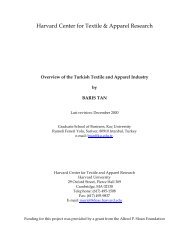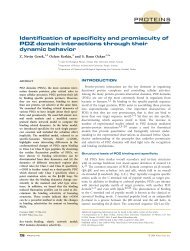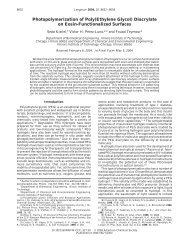Comment on Hekman's "Truth and Method: Feminist Standpoint ...
Comment on Hekman's "Truth and Method: Feminist Standpoint ...
Comment on Hekman's "Truth and Method: Feminist Standpoint ...
Create successful ePaper yourself
Turn your PDF publications into a flip-book with our unique Google optimized e-Paper software.
<str<strong>on</strong>g>Comment</str<strong>on</strong>g> <strong>on</strong> <strong>Hekman's</strong> "<strong>Truth</strong> <strong>and</strong> <strong>Method</strong>: <strong>Feminist</strong> St<strong>and</strong>point Theory Revisited": Where's<br />
the Power?<br />
Author(s): Patricia Hill Collins<br />
Source: Signs, Vol. 22, No. 2 (Winter, 1997), pp. 375-381<br />
Published by: The University of Chicago Press<br />
Stable URL: http://www.jstor.org/stable/3175278 .<br />
Accessed: 26/03/2013 07:55<br />
Your use of the JSTOR archive indicates your acceptance of the Terms & C<strong>on</strong>diti<strong>on</strong>s of Use, available at .<br />
http://www.jstor.org/page/info/about/policies/terms.jsp<br />
.<br />
JSTOR is a not-for-profit service that helps scholars, researchers, <strong>and</strong> students discover, use, <strong>and</strong> build up<strong>on</strong> a wide range of<br />
c<strong>on</strong>tent in a trusted digital archive. We use informati<strong>on</strong> technology <strong>and</strong> tools to increase productivity <strong>and</strong> facilitate new forms<br />
of scholarship. For more informati<strong>on</strong> about JSTOR, please c<strong>on</strong>tact support@jstor.org.<br />
.<br />
The University of Chicago Press is collaborating with JSTOR to digitize, preserve <strong>and</strong> extend access to Signs.<br />
http://www.jstor.org<br />
This c<strong>on</strong>tent downloaded from 212.175.32.130 <strong>on</strong> Tue, 26 Mar 2013 07:55:02 AM<br />
All use subject to JSTOR Terms <strong>and</strong> C<strong>on</strong>diti<strong>on</strong>s
<str<strong>on</strong>g>Comment</str<strong>on</strong>g> <strong>on</strong> <strong>Hekman's</strong> "<strong>Truth</strong> <strong>and</strong> <strong>Method</strong>: <strong>Feminist</strong><br />
St<strong>and</strong>point Theory Revisited": Where's the Power?<br />
Patricia<br />
Hill Collins<br />
Y READING OF STANDPOINT THEORY sees it<br />
as an interpretive framework dedicated to explicating how<br />
knowledge remains central to maintaining <strong>and</strong> changing<br />
unjust systems of power. While the main arguments in Susan<br />
<strong>Hekman's</strong> article (in this issue) c<strong>on</strong>tain surface validity, because st<strong>and</strong>point<br />
theory never was designed to be argued as a theory of truth or<br />
method, <strong>Hekman's</strong> article simply misses the point of st<strong>and</strong>point theory<br />
overall. By dec<strong>on</strong>textualizing st<strong>and</strong>poin theory from its initial moorings<br />
in a knowledge/power framework while simultaneously rec<strong>on</strong>textualizing<br />
it in an apolitical discussi<strong>on</strong> of feministruth <strong>and</strong> method, Hekman essentially<br />
depoliticizes the potentially radical c<strong>on</strong>tent of st<strong>and</strong>poin theory.<br />
First, the noti<strong>on</strong> of a st<strong>and</strong>point refers to historically shared, groupbased<br />
experiences. Groups have a degree of permanence over time such<br />
that group realities transcend individual experiences. For example, African<br />
Americans as a stigmatized racial group existed l<strong>on</strong>g before I was<br />
born <strong>and</strong> will probably c<strong>on</strong>tinue l<strong>on</strong>g after I die. While my individual<br />
experiences with instituti<strong>on</strong>alized racism will be unique, the types of opportunities<br />
<strong>and</strong> c<strong>on</strong>straints that I encounter <strong>on</strong> a daily basis will resemble<br />
those c<strong>on</strong>fr<strong>on</strong>ting African Americans as a group. Arguing that Blacks as<br />
a group come into being or disappear <strong>on</strong> the basis of my participati<strong>on</strong><br />
seems narcissistic, egocentric, <strong>and</strong> archetypally postmodern. In c<strong>on</strong>trast,<br />
st<strong>and</strong>point theory places less emphasis <strong>on</strong> individual experiences within<br />
socially c<strong>on</strong>structed groups than <strong>on</strong> the social c<strong>on</strong>diti<strong>on</strong>s that c<strong>on</strong>struct<br />
such groups.<br />
I stress this difference between the individual <strong>and</strong> the group as units of<br />
analysis because using these two c<strong>on</strong>structs as if they were interchangeable<br />
clouds underst<strong>and</strong>ing of a host of topics, in this case, the very noti<strong>on</strong><br />
of a group-based st<strong>and</strong>point. Individualism c<strong>on</strong>tinues as a taproot in<br />
Western theorizing, including feminist versi<strong>on</strong>s. Whether bourgeois liberalism<br />
positing noti<strong>on</strong>s of individual rights or postmodern social theory's<br />
celebrati<strong>on</strong> of human differences, market-based choice models grounded<br />
in individualism argue that freedom exists via the absence of c<strong>on</strong>straints<br />
of all sorts, including those of m<strong>and</strong>atory group membership. Freedom<br />
occurs when individuals have rights of mobility in <strong>and</strong> out of groups,<br />
much as we join clubs <strong>and</strong> other voluntary associati<strong>on</strong>s.<br />
[Signs: Journal of Women in Culture <strong>and</strong> Society 1997, vol. 22, no. 2]<br />
? 1997 by The University of Chicago. All rights reserved. 0097-9740/97/2202-0005$01.00<br />
Winter 1997 SIGNS 375<br />
This c<strong>on</strong>tent downloaded from 212.175.32.130 <strong>on</strong> Tue, 26 Mar 2013 07:55:02 AM<br />
All use subject to JSTOR Terms <strong>and</strong> C<strong>on</strong>diti<strong>on</strong>s
Collins<br />
COMMENT<br />
But the individual as proxy for the group becomes particularly problematic<br />
because st<strong>and</strong>pointheory's treatment of the group is not syn<strong>on</strong>ymous<br />
with a "family resemblance" of individual choice exp<strong>and</strong>ed to the<br />
level of voluntary group associati<strong>on</strong>. The noti<strong>on</strong> of st<strong>and</strong>point refers to<br />
groups having shared histories based <strong>on</strong> their shared locati<strong>on</strong> in relati<strong>on</strong>s<br />
of power-st<strong>and</strong>points arise neither from crowds of individuals nor from<br />
groups analytically created by scholars or bureaucrats. Take, for example,<br />
the comm<strong>on</strong>ality of experiences that emerges from l<strong>on</strong>g-st<strong>and</strong>ing patterns<br />
of racial segregati<strong>on</strong> in the United States. The degree of racial segregati<strong>on</strong><br />
between Blacks <strong>and</strong> Whites as groups is routinely underestimated. Blacks<br />
<strong>and</strong> Whites live in racially segregated neighborhoods, <strong>and</strong> this basic feature<br />
generates distinctivexperiences in schools, recreati<strong>on</strong>al facilities,<br />
shopping areas, health-care systems, <strong>and</strong> occupati<strong>on</strong>al opportunities.<br />
Moreover, middle-class Blacks have not been exempt from the effects of<br />
diminished opportunities that accompany racial segregati<strong>on</strong> <strong>and</strong> group<br />
discriminati<strong>on</strong>. It is comm<strong>on</strong> locati<strong>on</strong> within hierarchical power relati<strong>on</strong>s<br />
that creates groups, not the results of collective decisi<strong>on</strong> making of the<br />
individuals within the groups. Race, gender, social class, ethnicity, age,<br />
<strong>and</strong> sexuality are not descriptive categories of identity applied to individuals.<br />
Instead, these elements of social structuremerge as fundamental<br />
devices that foster inequality resulting in groups.<br />
To ignore power relati<strong>on</strong>s is simply to misread st<strong>and</strong>point theoryits<br />
rais<strong>on</strong> d'etre, its c<strong>on</strong>tinuing salience, <strong>and</strong> its ability to explain social<br />
inequality. <strong>Hekman's</strong> treatment of groups as an accumulati<strong>on</strong> of individuals<br />
<strong>and</strong> not as entities with their own reality allows her to do just this.<br />
Note the slippage between individual <strong>and</strong> group st<strong>and</strong>point in the following<br />
passage: "If we take the multiplicity of feminist st<strong>and</strong>points to its<br />
logical c<strong>on</strong>clusi<strong>on</strong>, coherent analysis becomes impossible because we have<br />
too many axes of analysis. Ultimately, every woman is unique; if we analyze<br />
each in her uniqueness, systemic analysis is obviated. So is feminist<br />
politics: we lose the ability even to speak for certain categories of women"<br />
(359). Hekman clearly identifies the very c<strong>on</strong>struct of st<strong>and</strong>point with the<br />
idea of individual perspective or point of view. This assumpti<strong>on</strong> allows<br />
her to collapse the individual <strong>and</strong> group as units of analysis <strong>and</strong> proceed<br />
to reas<strong>on</strong> that individuals <strong>and</strong> collectivities undergo similar processes.<br />
But because she remains focused <strong>on</strong> the individual as proxy for the group,<br />
it becomes difficult to c<strong>on</strong>structhe group from such "unique" individuals.<br />
Arriving at the dead end of the impossibility of systemic analysis that<br />
leads to systemichange appears as the result. By omitting a discussi<strong>on</strong><br />
of group-based realities grounded in an equally central noti<strong>on</strong> of groupbased<br />
oppressi<strong>on</strong>, we move into the sterile ground of a discussi<strong>on</strong> of how<br />
effectively st<strong>and</strong>poin theory serves as an epistemology of truth.<br />
In c<strong>on</strong>trast to <strong>Hekman's</strong> view that attenti<strong>on</strong> to multiplicity fosters in-<br />
376 SIGNS Winter 1997<br />
This c<strong>on</strong>tent downloaded from 212.175.32.130 <strong>on</strong> Tue, 26 Mar 2013 07:55:02 AM<br />
All use subject to JSTOR Terms <strong>and</strong> C<strong>on</strong>diti<strong>on</strong>s
COMMENT<br />
Collins<br />
coherence, current attenti<strong>on</strong> to the theme of intersecti<strong>on</strong>ality situated<br />
within assumpti<strong>on</strong>s of group-based power relati<strong>on</strong>s reveals a growing underst<strong>and</strong>ing<br />
of the complexity of the processes both of generatingroups<br />
<strong>and</strong> accompanying st<strong>and</strong>points. Initially examining <strong>on</strong>ly <strong>on</strong>e dimensi<strong>on</strong><br />
of power relati<strong>on</strong>s, namely, that of social class, Marx posited that, however<br />
unarticulated <strong>and</strong> inchoate, oppressed groups possessed a particular<br />
st<strong>and</strong>point <strong>on</strong> inequality. In more c<strong>on</strong>temporary versi<strong>on</strong>s, inequality has<br />
been revised to reflect a greater degree of complexity, especially that of<br />
race <strong>and</strong> gender. What we now have is increasing sophisticati<strong>on</strong> about<br />
how to discuss group locati<strong>on</strong>, not in the singular social class framework<br />
proposed by Marx, nor in the early feminist frameworks arguing the primacy<br />
of gender, but within c<strong>on</strong>structs of multiplicity residing in social<br />
structures themselves <strong>and</strong> not in individual women. Fluidity does not<br />
mean that groups themselves disappear, to be replaced by an accumulati<strong>on</strong><br />
of dec<strong>on</strong>texualized, unique women whose complexity erases politics.<br />
Instead, the fluidity of boundaries operates as a new lens that potentially<br />
deepens underst<strong>and</strong>ing of how the actual mechanisms of instituti<strong>on</strong>al<br />
power can change dramatically while c<strong>on</strong>tinuing to reproduce l<strong>on</strong>gst<strong>and</strong>ing<br />
inequalities of race, gender, <strong>and</strong> class that result in group stability.<br />
In this sense, group history <strong>and</strong> locati<strong>on</strong> can be seen as points of c<strong>on</strong>vergence<br />
within hierarchical, multiple, <strong>and</strong> changing structural power<br />
relati<strong>on</strong>s.<br />
A sec<strong>on</strong>d feature of st<strong>and</strong>point theory c<strong>on</strong>cerns the comm<strong>on</strong>ality of<br />
experiences <strong>and</strong> perspectives that emerge for groups differentially arrayed<br />
within hierarchical power relati<strong>on</strong>s. Keep in mind that if the group has<br />
been theorized away, there can be no comm<strong>on</strong> experiences or perspectives.<br />
St<strong>and</strong>point theory argues that groups who share comm<strong>on</strong> placement<br />
in hierarchical power relati<strong>on</strong>s also share comm<strong>on</strong> experiences in<br />
such power relati<strong>on</strong>s. Such shared angles of visi<strong>on</strong> lead those in similar<br />
social locati<strong>on</strong>s to be predisposed to interpret these experiences in a comparable<br />
fashi<strong>on</strong>. The existence of the group as the unit of analysis neither<br />
means that all individuals within the group have the same experiences nor<br />
that they interprethem in the same way. Using the group as the focal<br />
point provides space for individual agency. While these themes remain<br />
meritorious, they simply do not lie at the center of st<strong>and</strong>point theory as<br />
a theory of group power <strong>and</strong> the knowledges that group locati<strong>on</strong> <strong>and</strong><br />
power generate.<br />
Unfortunately, the much-deserved attenti<strong>on</strong> to issues of individual<br />
agency <strong>and</strong> diversity often overshadow investigating the c<strong>on</strong>tinued salience<br />
of group-based experiences. But group-based experience, especially<br />
that of race <strong>and</strong>/or social class, c<strong>on</strong>tinues to matter. For example, African-<br />
American male rates of incarcerati<strong>on</strong> in American jails <strong>and</strong> pris<strong>on</strong>s<br />
remain the highest in the world, exceeding even those of South Africa.<br />
Winter 1997 SIGNS 377<br />
This c<strong>on</strong>tent downloaded from 212.175.32.130 <strong>on</strong> Tue, 26 Mar 2013 07:55:02 AM<br />
All use subject to JSTOR Terms <strong>and</strong> C<strong>on</strong>diti<strong>on</strong>s
Collins<br />
COMMENT<br />
Transcending social class, regi<strong>on</strong> of residence, comm<strong>and</strong> of English, ethnic<br />
background, or other markers of difference, all Black men must in<br />
some way grapple with the actual or potential treatment by the criminal<br />
justice system. Moreover, as mothers, daughters, wives, <strong>and</strong> lovers of<br />
Black men, Black women also participate in this comm<strong>on</strong> experience.<br />
Similarly, children from poor communities <strong>and</strong> homeless families are unlikely<br />
to attend college, not because they lack talent, but because they<br />
lack opportunity. Whatever their racial/ethnic classificati<strong>on</strong>, poor people<br />
as a group c<strong>on</strong>fr<strong>on</strong>t similar barriers for issues of basic survival. In this<br />
sense, st<strong>and</strong>point theory seems especially suited to explaining relati<strong>on</strong>s<br />
of race <strong>and</strong>/or social class because these systems of power share similar<br />
instituti<strong>on</strong>al structures. Given the high degree of residential <strong>and</strong> occupati<strong>on</strong>al<br />
segregati<strong>on</strong> separating Black <strong>and</strong>/or working-class groups from<br />
White middle-class realities, it becomes plausible to generate arguments<br />
about working-class <strong>and</strong>/or Black culture that emerge from l<strong>on</strong>g-st<strong>and</strong>ing<br />
shared experiences. For both class <strong>and</strong> race, a much clearer case of a<br />
group st<strong>and</strong>point can be c<strong>on</strong>structed. Whether individuals from or associated<br />
with these groups accept or reject these histories, they recognize the<br />
saliency of the noti<strong>on</strong> of group st<strong>and</strong>point.<br />
But gender raises different issues, for women are distributed across<br />
these other groups. In c<strong>on</strong>trast to st<strong>and</strong>points that must learn to accommodate<br />
differences within, feminist st<strong>and</strong>points must be c<strong>on</strong>structed<br />
across differences such as these. Thus, gender represents a distinctly different<br />
intellectual <strong>and</strong> political project within st<strong>and</strong>pointheory. How effectively<br />
can a st<strong>and</strong>poin theory that was originally developed to explicate<br />
the wage exploitati<strong>on</strong> <strong>and</strong> subsequent impoverishment of European,<br />
working-class populati<strong>on</strong>s be applied to the extremely heterogeneous<br />
populati<strong>on</strong> of women in the c<strong>on</strong>temporary United States, let al<strong>on</strong>e globally?<br />
For example, Black women <strong>and</strong> White women do not live in racially<br />
integrated women's communities, separated from men <strong>and</strong> children by<br />
processes such as gender steering into such communities, experience bank<br />
redlining that results in refusal to lend m<strong>on</strong>ey to women's communities,<br />
attend inferior schools as a result of men moving to all-male suburban<br />
areas, <strong>and</strong> the like. Instead, Black <strong>and</strong> White women live in racially segregated<br />
communities, <strong>and</strong> the experiences they garner in such communities<br />
reflecthe racial politics operating overall. Moreover, proximity in physical<br />
space is not necessarily the same as occupying a comm<strong>on</strong> locati<strong>on</strong> in<br />
the space of hierarchical power relati<strong>on</strong>s. For example, Black women <strong>and</strong><br />
women of color routinely share academic office space with middle-class<br />
<strong>and</strong>/or White women academics. It is quite comm<strong>on</strong> for women of color<br />
to clean the office of the feminist academic writing the latest treatise <strong>on</strong><br />
st<strong>and</strong>poin theory. While these women occupy the same physical spacethis<br />
is why proximity should not be c<strong>on</strong>fused with group solidarity-they<br />
378 SIGNS Winter 1997<br />
This c<strong>on</strong>tent downloaded from 212.175.32.130 <strong>on</strong> Tue, 26 Mar 2013 07:55:02 AM<br />
All use subject to JSTOR Terms <strong>and</strong> C<strong>on</strong>diti<strong>on</strong>s
COMMENT<br />
Collins<br />
occupy fundamentally different locati<strong>on</strong>s in hierarchical power relati<strong>on</strong>s.<br />
These women did not just enter this space in a r<strong>and</strong>om fashi<strong>on</strong>. An entire<br />
arsenal of social instituti<strong>on</strong>s collectively created paths in which the individuals<br />
assigned to <strong>on</strong>e group received better housing, health care, educati<strong>on</strong>,<br />
<strong>and</strong> recreati<strong>on</strong>al facilities, while those relegated to the other group<br />
did with worse or did without. The accumulati<strong>on</strong> of these different experiences<br />
led the two groups of women to that same academic space. The<br />
actual individuals matter less than the accumulati<strong>on</strong> of social structures<br />
that lead to these outcomes. In this sense, developing a political theory<br />
for women involves c<strong>on</strong>fr<strong>on</strong>ting a different <strong>and</strong> more complex set of issues<br />
than that facing race theories or class-based theories because women's<br />
inequality is structuredifferently.<br />
There is a third theme of st<strong>and</strong>point theory in which power is erased,<br />
namely, the significance of group c<strong>on</strong>sciousness, group self-definiti<strong>on</strong>, <strong>and</strong><br />
"voice" within this entire structure of power <strong>and</strong> experience. Collapsing<br />
individual <strong>and</strong> group identity emerges here as significant because applying<br />
st<strong>and</strong>point theory to the individual as proxy for the group becomes particularly<br />
problematic in comparing individual voice with group voice or<br />
st<strong>and</strong>point. Typically, this process operates via imagining how individuals<br />
negotiate self-definiti<strong>on</strong>s <strong>and</strong> then claiming a "family resemblance" positing<br />
that collectivities undergo a similar process. Because collectivities<br />
certainly do c<strong>on</strong>struct stories in framing their identity, this approach appears<br />
plausible. But can the individual st<strong>and</strong> as proxy for the group <strong>and</strong><br />
the group for the individual? Moreover, can this particular versi<strong>on</strong> of the<br />
individual serve as the exemplar for collective group identity?<br />
If an individual reas<strong>on</strong>s from his or her own pers<strong>on</strong>al experiences by<br />
imagining that since "we are all the same under the skin, therefore, what<br />
I experience must be the same as what everybody else experiences," then<br />
a certain percepti<strong>on</strong> of group narrative structuremerges. If an individual<br />
believes that his or her pers<strong>on</strong>al experiences in coming to voice, especially<br />
the inner voices within his or her own individual c<strong>on</strong>sciousness hidden<br />
from hierarchal power relati<strong>on</strong>s, not <strong>on</strong>ly reflect a comm<strong>on</strong> human experience<br />
but, more to the point, also serve as an exemplar for how group<br />
c<strong>on</strong>sciousness <strong>and</strong> decisi<strong>on</strong> making operate, then individual experience<br />
becomes the model for comprehendingroup processes. This approach<br />
minimizes the significance of c<strong>on</strong>flict within groups in generatin group<br />
narratives. In the model in which an individual c<strong>on</strong>ducts inner dialogues<br />
am<strong>on</strong>g various parts of his or her "self," the process of mediating c<strong>on</strong>flicting<br />
identities occurs within each individual. The individual always<br />
holds complete power or agency over the c<strong>on</strong>sciousness that he or she<br />
c<strong>on</strong>structs in his or her own mind <strong>and</strong> the voice that she or he uses to<br />
express that c<strong>on</strong>sciousness.<br />
Shifting this mode of coming to voice to the level of the small group<br />
Winter 1997 SIGNS 379<br />
This c<strong>on</strong>tent downloaded from 212.175.32.130 <strong>on</strong> Tue, 26 Mar 2013 07:55:02 AM<br />
All use subject to JSTOR Terms <strong>and</strong> C<strong>on</strong>diti<strong>on</strong>s
Collins<br />
COMMENT<br />
provides space to think of groups as collecti<strong>on</strong>s of individuals engaged<br />
in dialogue with <strong>on</strong>e another. As equal <strong>and</strong> different, the c<strong>on</strong>cern lies in<br />
finding rules to decide whose voice has most validity. By asking, "If we<br />
acknowledge multiple realities, multiple st<strong>and</strong>points, how do we discriminate<br />
am<strong>on</strong>g them?" (359), Hekman c<strong>on</strong>tinues the search for rules that<br />
every<strong>on</strong>e can follow in order to come to a collective "voice." Within the<br />
scope of individuals engaged in face-to-face interacti<strong>on</strong>, this seems reas<strong>on</strong>able.<br />
But does this work with the underst<strong>and</strong>ing of group that underlies<br />
st<strong>and</strong>poin theory?<br />
Hekman quite rightly recognizes that multiple realities yield multiple<br />
perspectives <strong>on</strong> reality. But again, her c<strong>on</strong>cern with the questi<strong>on</strong> of who<br />
has the best, "truest," or privileged st<strong>and</strong>point remains grounded in ambiguous<br />
noti<strong>on</strong>s of group that omit group-based c<strong>on</strong>flicts <strong>and</strong> how hierarchical<br />
power relati<strong>on</strong>s generate differences in group voice or st<strong>and</strong>point.<br />
Bracketing the questi<strong>on</strong> of power <strong>and</strong> restricting argument solely to the<br />
questi<strong>on</strong> of truth certainly reveals the limitati<strong>on</strong>s of using epistemological<br />
criteria in defense of privileged st<strong>and</strong>points. But within the reality of hierarchical<br />
power relati<strong>on</strong>s, the st<strong>and</strong>points of some groups are most certainly<br />
privileged over others. The amount of privilege granted to a particular<br />
st<strong>and</strong>point lies less in its internal criteria in being truthful, the terrain<br />
in which Hekman situates her discussi<strong>on</strong>, <strong>and</strong> more in the power of a<br />
group in making its st<strong>and</strong>point prevail over other equally plausible perspectives.<br />
Within hierarchical power relati<strong>on</strong>s, it seems reas<strong>on</strong>able that<br />
groups disadvantaged by systems of power might see their strength in solidarity<br />
<strong>and</strong> collective resp<strong>on</strong>ses to their comm<strong>on</strong> locati<strong>on</strong> <strong>and</strong> subjugati<strong>on</strong>.<br />
In c<strong>on</strong>trast, it seems equally plausible that those privileged by these<br />
types of group placements might want to do away with noti<strong>on</strong>s of the<br />
group altogether, in effect obscuring the privileges they gain from group<br />
membership.<br />
Again, gender raises some particular challenges in using st<strong>and</strong>point<br />
theory to representhe st<strong>and</strong>point of women. One fundamental c<strong>on</strong>tributi<strong>on</strong><br />
of feminist movement grounded in st<strong>and</strong>point theory was that it<br />
aimed to bring women's group c<strong>on</strong>sciousness into being. Early emphasis<br />
<strong>on</strong> women's coming to voice via the process of c<strong>on</strong>sciousness-raising <strong>and</strong><br />
claiming individual "voice" inadvertently laid the foundati<strong>on</strong> for the type<br />
of c<strong>on</strong>ceptual ambiguity between individual <strong>and</strong> group as categories of<br />
analysis. C<strong>on</strong>temporary feministheorizing, especially the emergence of<br />
postmodern social theory's theme of dec<strong>on</strong>structing the subject, aggravates<br />
this l<strong>on</strong>g-st<strong>and</strong>ing commitmento bringing individual women to<br />
voice as emblematic of the collective struggle of women for "voice." Collapsing<br />
the processes of individual <strong>and</strong> group voice <strong>and</strong> using the process<br />
of individual women coming to voice as emblematic of women's collective<br />
coming to voice reinforces this noti<strong>on</strong> that individual <strong>and</strong> collective voice<br />
380 SIGNS Winter 1997<br />
This c<strong>on</strong>tent downloaded from 212.175.32.130 <strong>on</strong> Tue, 26 Mar 2013 07:55:02 AM<br />
All use subject to JSTOR Terms <strong>and</strong> C<strong>on</strong>diti<strong>on</strong>s
COMMENT<br />
Collins<br />
or st<strong>and</strong>point are the same. For many c<strong>on</strong>temporary feminists, voicing<br />
their disc<strong>on</strong>tent with oppressi<strong>on</strong> is sufficient-actually changing instituti<strong>on</strong>al<br />
power relati<strong>on</strong>s seems less important. Gaining voice <strong>on</strong>ly to lose it<br />
again to a st<strong>and</strong>point theory that replaces the freedom of individually<br />
negotiated friendships or sisterhood with the obligati<strong>on</strong>s of race, class,<br />
<strong>and</strong> gender "families" seems unacceptable to those with the means to<br />
escape.<br />
St<strong>and</strong>poin theory argues that ideas matter in systems of power. In this<br />
sense, st<strong>and</strong>points may be judged not <strong>on</strong>ly by their epistemological c<strong>on</strong>tributi<strong>on</strong>s<br />
but also by the terms of their participati<strong>on</strong> in hierarchical power<br />
relati<strong>on</strong>s. Do they inherently explain <strong>and</strong> c<strong>on</strong>d<strong>on</strong>e injustice, or do they<br />
challenge it? Do they participate in relati<strong>on</strong>s of rule via creating knowledge,<br />
or do they reject such rule by generating cultures of resistance? Extracting<br />
any claims about knowledge from the power relati<strong>on</strong>s in which<br />
they are embedded violates the basic premise of st<strong>and</strong>point theory because<br />
such theory exists primarily to explicate these power relati<strong>on</strong>s.<br />
Thus, attempts to take the knowledge while leaving the power behind<br />
inadvertently operate within the terrain of privileged knowledge. While I<br />
respect postmodern c<strong>on</strong>tributi<strong>on</strong>s in dec<strong>on</strong>structing languages of power,<br />
st<strong>and</strong>poin theory encompasses much more than changing the "language<br />
game of politics" (363). Oppressi<strong>on</strong> is not a game, nor is it solely about<br />
language-for many of us, it still remains profoundly real.<br />
Department of African-American Studies<br />
University of Cincinnati<br />
Winter 1997 SIGNS 381<br />
This c<strong>on</strong>tent downloaded from 212.175.32.130 <strong>on</strong> Tue, 26 Mar 2013 07:55:02 AM<br />
All use subject to JSTOR Terms <strong>and</strong> C<strong>on</strong>diti<strong>on</strong>s


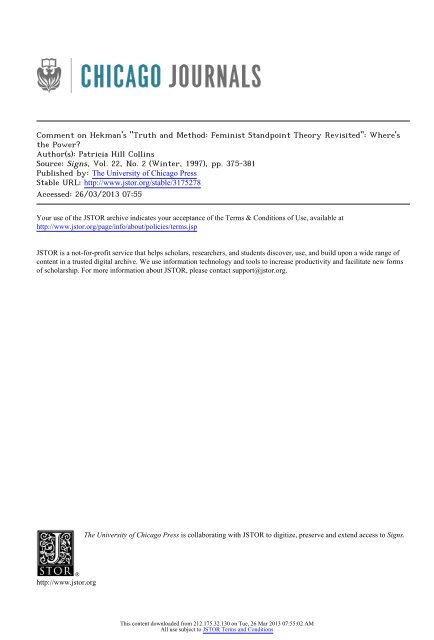
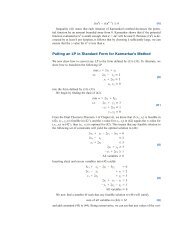
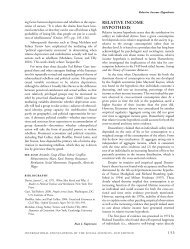

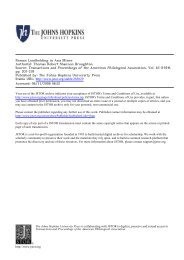
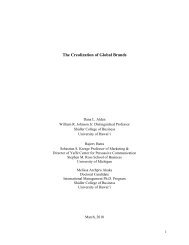

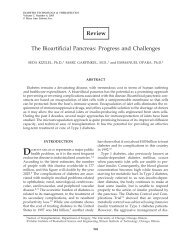
![]_[O](https://img.yumpu.com/10363126/1/190x138/-o.jpg?quality=85)
